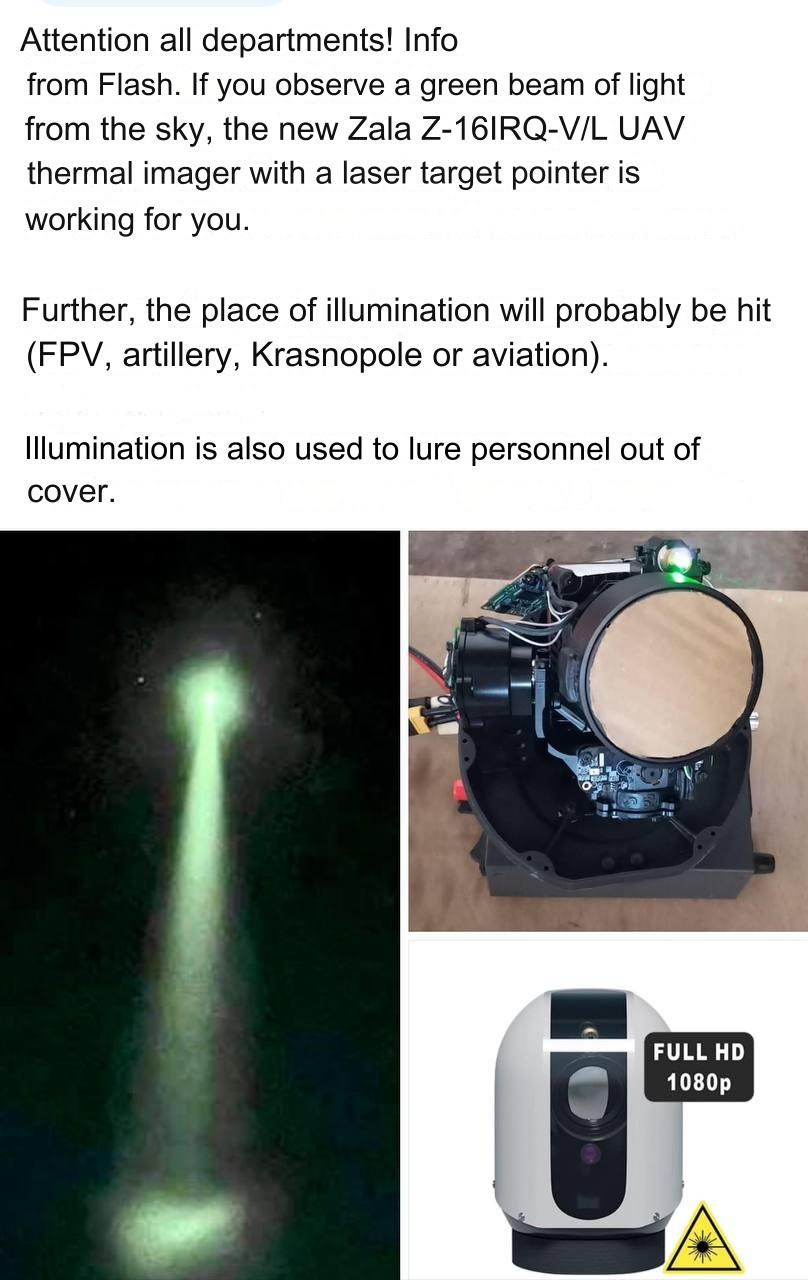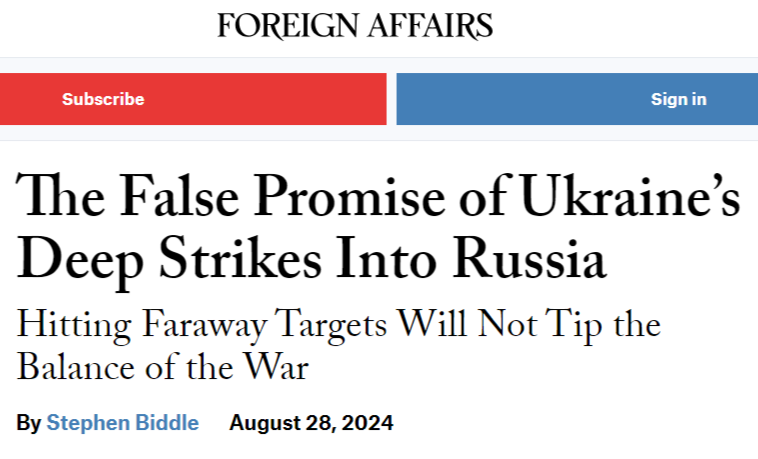Last of the Wunderwaffen? F-16 Blasted Out of Sky in First Mission – Simplicius
Fri 11:13 am +00:00, 30 Aug 2024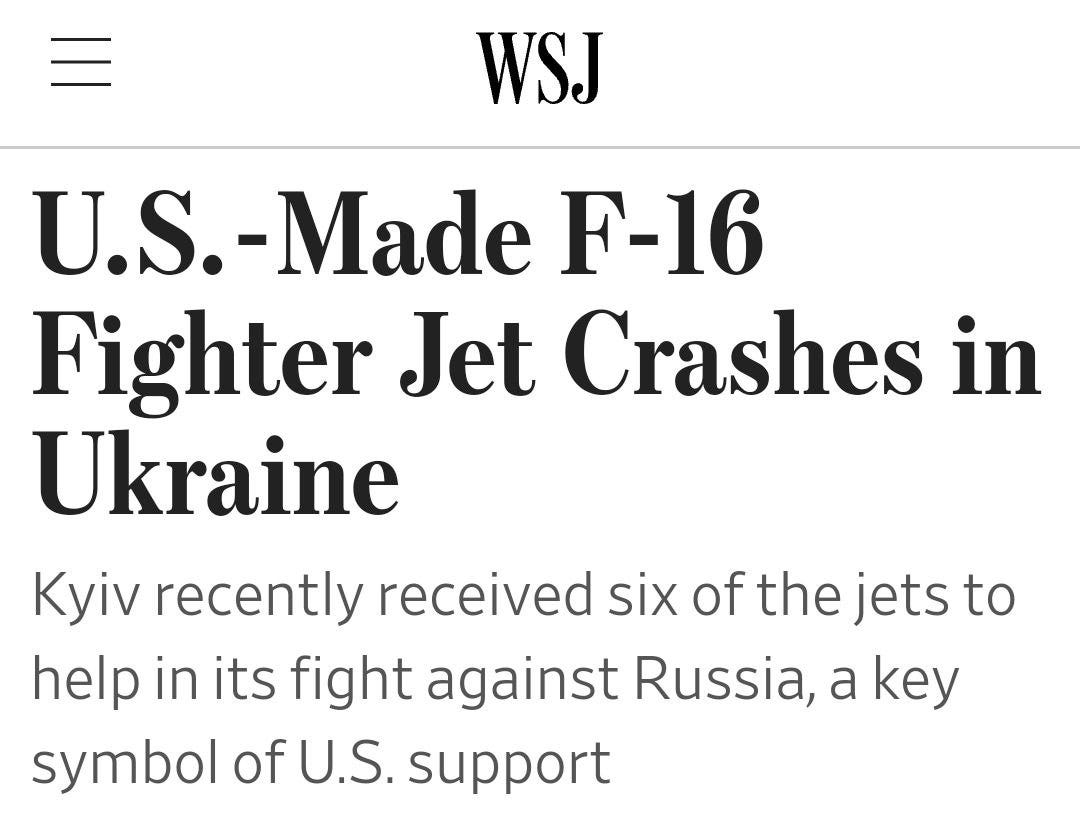
Well, the quintessential ‘game-changer’ of all game-changers was unceremoniously shot out of the sky on its maiden mission.
As I had stated from the get-go, F-16s were being utilized only in “safe” defensive roles in the far rear of the country to help shoot down Russian drones. Apparently even this task was too great for the poor F-16.
Official report from the Ukrainian General Staff:
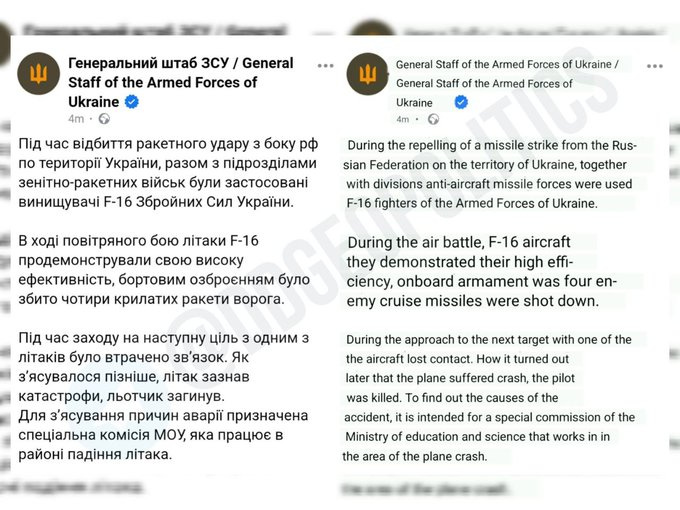
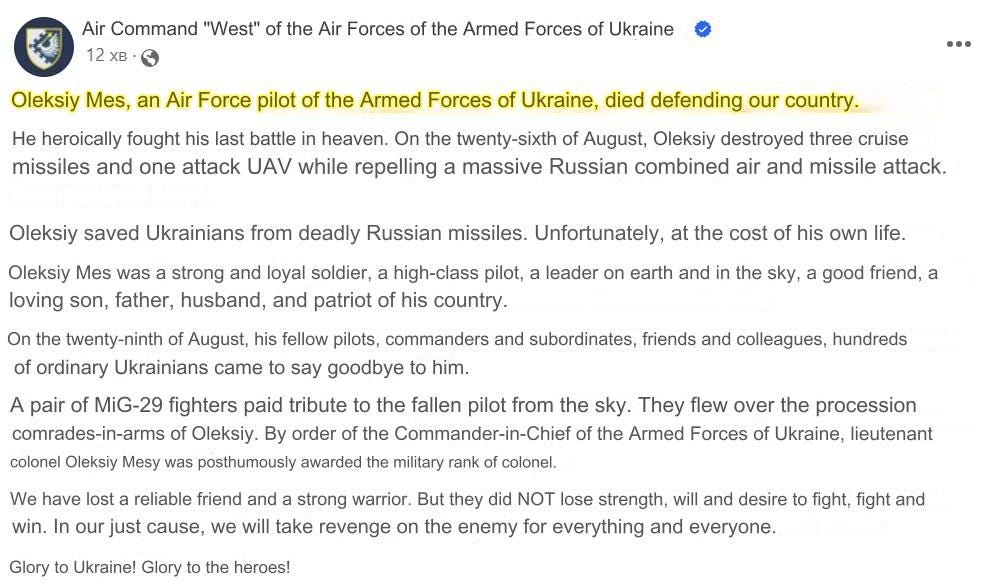
But the more shocking detail was revealed when Ukrainian Rada rep Mariana Bezuglaya claimed on her official account that the F-16 was kiboshed by none other than a friendly American-made Patriot missile system. Face palm.
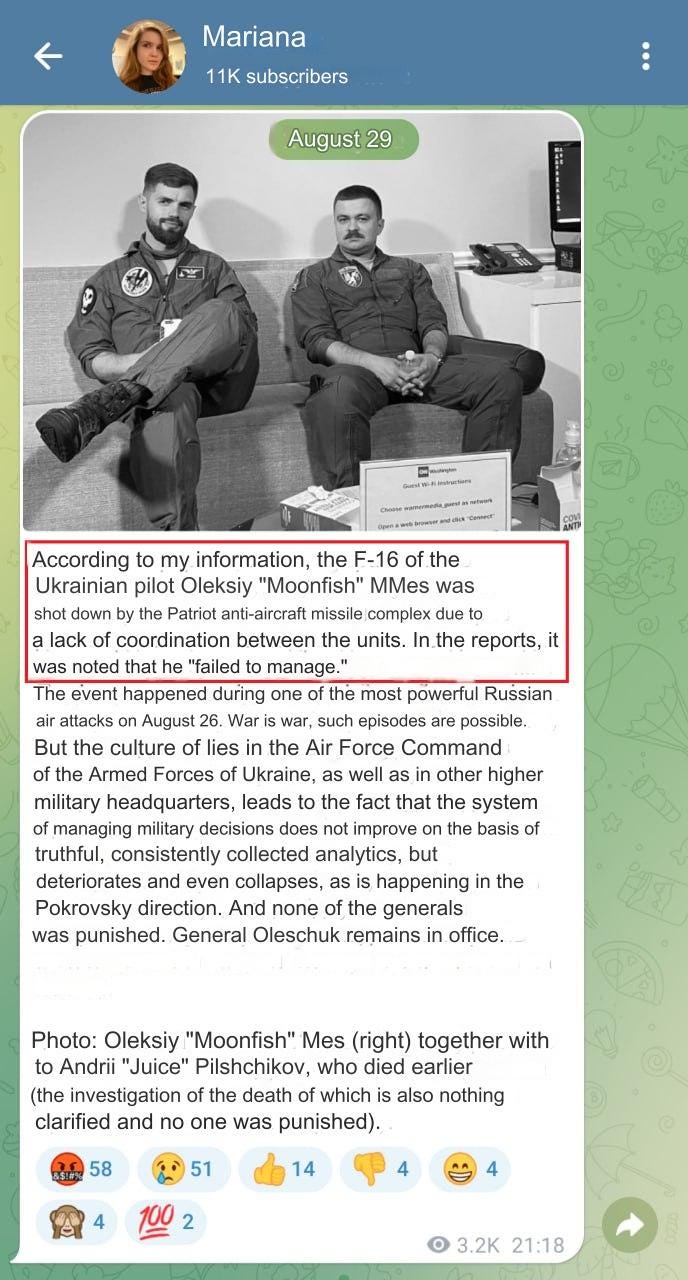
Pentagon spokesperson Sabrina Singh confirmed the loss but refused to comment on whether it was indeed a Patriot that brought the plane down:
Another top Ukrainian channel stated that the Ukrainian F-16s in fact received the most advanced of NATO’s electronic warfare packages which would have made the F-16 completely “invisible” to the inferior Russian radar technology:

Well, either the Patriot is a superlative radar or the plane wasn’t quite as invisible as advertised.
The truth is, this incident shows several things:
1. IFF is harder than it looks. Either NATO IFF (Identity Friend Foe) systems do not work well, which is funny considering all the jeers at Russian IFF during the claimed friendly fire shoot downs of A-50s, etc.; or the US simply never bothered to give Ukraine IFF codes between the Patriot and F-16.
2. The pro-UA crowd likewise laughed at other Russian friendly fire shoot downs, particularly those that happened during extremely contested air defense missions when dozens of Ukrainian missiles and drones were in the sky. Now they have a taste of their own medicine as they can see that things get quite a bit frenetic and even the best of them can accidentally shoot down their own planes when the radar screens are filled with dozens of targets.
It’s also quite possible—and in fact probably more plausible than the official story—that the F-16 did not gloriously go down swinging, after heroically shooting down several Russian drones and missiles, but that it was infact destroyed on the ground just as the Russian MOD had stated. You’ll recall during the large-scale strikes days ago, the Russian MOD said two F-16s were potentially destroyed in their hangars.
How would the pilot have been killed, you ask?
I would think like so: when the initial missile launches were recorded, Ukrainian pilots were sent to begin scrambling the jets to the sky to keep them out of harm’s way, as is standard for both sides. They know the exact speed and trajectory of Russian cruise missiles and can calculate the precise time they have until the missiles potentially reach the airfield in the west of the country.
The problem is: they can’t calculate Kinzhals in the same way. While they were initiating scrambling procedures, Russia may have fired some Kinzhals which would have reached the airfield in as little as under 3 minutes. Such a hypersonic missile could have hit the hangars even as the Ukrainian pilots were prepping the jets.
All in all, it’s a testament to the fact that modern near-peer, high-intensity conflict is not about wunderwaffe and ‘game changer’ toys. There is no such thing as a golden bullet or unicorn weapon that can really move the needle in near-peer conflict. It’s all about the totality of what your nation as a whole can bring to the table, economically, militarily, productively, and in terms of willpower, political influence, morale, etc. Any single weapon system is meaningless in the grand scheme of things and can be destroyed easily by the plethora of available modern counter-systems.
—
Now, the central narrative has fully shifted to the question of “long range strikes” on Russia. It’s clearer than ever that this is the final strategic gimmick Zelensky has left in his bag to stoke a conflict between NATO and Russia.
Listen as CNN explains how top Ukrainian officials are en route to speak to Biden directly about opening up this final Pandora’s box:

There really is nothing left other than to launch massive provocations by whisking ATACMS and Storm Shadows as deep into Russia as possible.
But here’s the ultimate catch that the vast majority of observers do not understand: U.S.’ hesitancy is not about fear that Russia will lose and what “uncontrollable” chaos that would entail, as Ukrainian commentators keep telling us. No, rather it’s the opposite—the U.S. fears that Ukraine may provoke Russia to go “all out”, which would unfetter Putin from his “soft” approach to wage some kind of all out war that would result in Ukraine either being destroyed or totally subjugated.
You see, the smarter American policy advisors know that the only chance the West has to topple Russia, is to keep this conflict a slow boil such that Putin “sleep walks” into a trap, buying time for the regime to foment opposition against him. But Ukraine stands to accidentally unleash the full extent of the Russian war machine—which could encompass an official declaration of war, or simply the abrogation of all former “rules” against striking civilian objects, government buildings, leadership, Kiev in general, etc. This, Washington knows, would lead to Russia definitively occupying all of Ukraine, which would mean the end of the entire Ukrainian project 70 years in the making by the CIA and co.
In short: they want to bleed the bear slowly by poking it over and over such that the bear doesn’t even realize it’s bleeding out; what they don’t want is puncturing the bear so hard that he erupts into a frothy rage and beheads them with a grisly swipe of his claws.
Interestingly, a new Foreign Affairs piece—from the people of the Council on Foreign Relations—argues that it would be militarily futile to allow deep strikes into Russia:
Career apparatchik Stephen Biddle argues that to have true strategic effect, Ukraine would have to combine such long range strikes with some massively successful maneuver warfare advances—which they simply don’t have the capability for at the moment:
From a strictly military perspective, restrictions never help. Giving Ukraine the means and permission to launch attacks deep into Russian-held territory would surely improve Ukrainian combat power. But the difference is unlikely to be decisive. To achieve a game-changing effect, Ukraine would need to combine these strikes with tightly coordinated ground maneuver on a scale that its forces have been unable to master so far in this war. Otherwise, the benefits Ukraine could draw from additional deep strike capability would probably not be enough to turn the tide.

To argue his point, he uses several historical precedents, including allied bombing of Germany in WWII which saw over 700,000 aircraft drop millions of bombs, only for German production to subsequently increase:
During World War II, the Allied powers used more than 710,000 aircraft to drop over two million tons of bombs on Germany over three and a half years—and German weapons production still rose between January 1942 and July 1944. Only in the war’s final months, after the German air force had been largely destroyed, did this enormous campaign incapacitate German ground forces. Even with the benefit of modern technology, no plausible transfer of Western weapons today would enable Ukraine to carry out a campaign that is remotely comparable in scope.
In his final paragraph he hints at my thesis, raising the question of whether it’s worth the escalatory risk for so little gain:
With that in mind, Kyiv’s partners should now ask whether the modest military benefits are worth the escalatory risk. The answer will turn on assessments of the likelihood of expanding the conflict and on the risk tolerance of Western governments and publics. The latter is ultimately a value judgment; military analysis alone cannot dictate where to draw the line. What it can do is forecast the battlefield consequences of policy decisions. If the West lifts its restraints on Ukrainian deep strike capability, the consequences are unlikely to include a decisive change in the trajectory of the war.

The Ukrainian frontline continues to collapse, and we’re starting to see cracks forming in other places, which—should they develop—would be a very bad sign for the AFU. Right now the collapse is still localized to one front, albeit the most significant front of the war. However, it still does imply that, while Russia gathered its most powerful fist in this direction, it may have done so at the expense of other fronts, whose groupings are too weak to move forward.
One Ukrainian source:
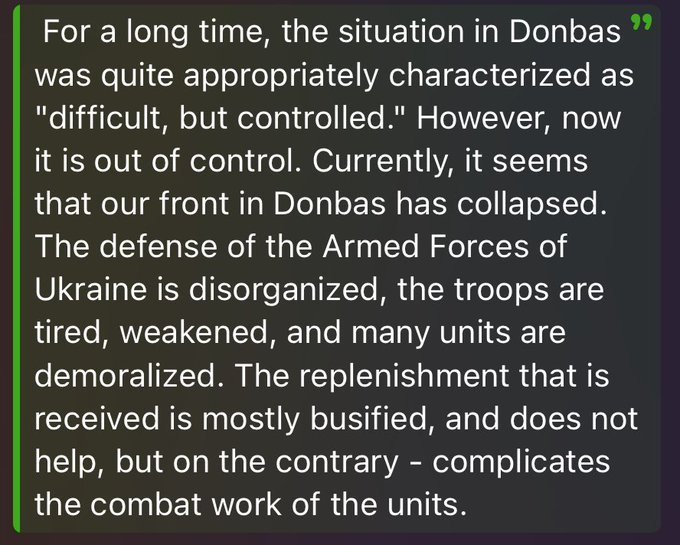
An AFU volunteer writes about the lies and incompetence responsible for the ongoing Pokrovsk collapse:
The defense in the Pokrovsky direction is so disorganized that the Russians themselves do not believe in their advances.
Unfortunately, the higher command is still receiving reports about the “controlled situation”, which is far from being controlled. Among the main problems in the direction:
– poor interaction between brigades and smaller adjacent units.
– shortage of people and their disproportionate distribution in defensive positions.
– our EW suppresses our drones better than enemy EW.
– disorganization of brigade rotations. One can leave before the other has entered. The enemy uses this and strikes right there.
– the OTU command does not actually manage the troops, has not established interaction and does not have information about our real positions. There are often cases of units being sent to positions that are already in the rear of the Russians, because the OTU thinks that they are behind us.
– lies, lies and lies again.
But my contention is that, if and when we start seeing multiple Ukrainian fronts collapsing at the same time, that will be the final siren song notifying us that the ‘snowball effect’ has truly begun and that Russian manpower is now overwhelmingly superior as a generality. That’s because as a last desperation move, Ukraine would be forced to pull forces from other fronts just to plug holes to keep from being entirely overrun and surrounded. The fact they’re not necessarily doing this yet likely means there are still some reserves available. When those reserves run out, it can create a cascading effect where reserves are pulled from other fronts, and then those fronts subsequently begin collapsing just as fast as the Pokrovsk one. Only then can we say that the AFU’s final stanza has begun.
At the moment, it’s not clear just yet, but there are some rumblings, as if the foundation is giving a little portentous shake or two. For instance, Russian forces have advanced in Urozhayne, Zaporozhye; in Kupyansk, they suddenly sprang forward and captured Sinkovka—or at least most of it—a town they’ve been contesting for something like a year or more:
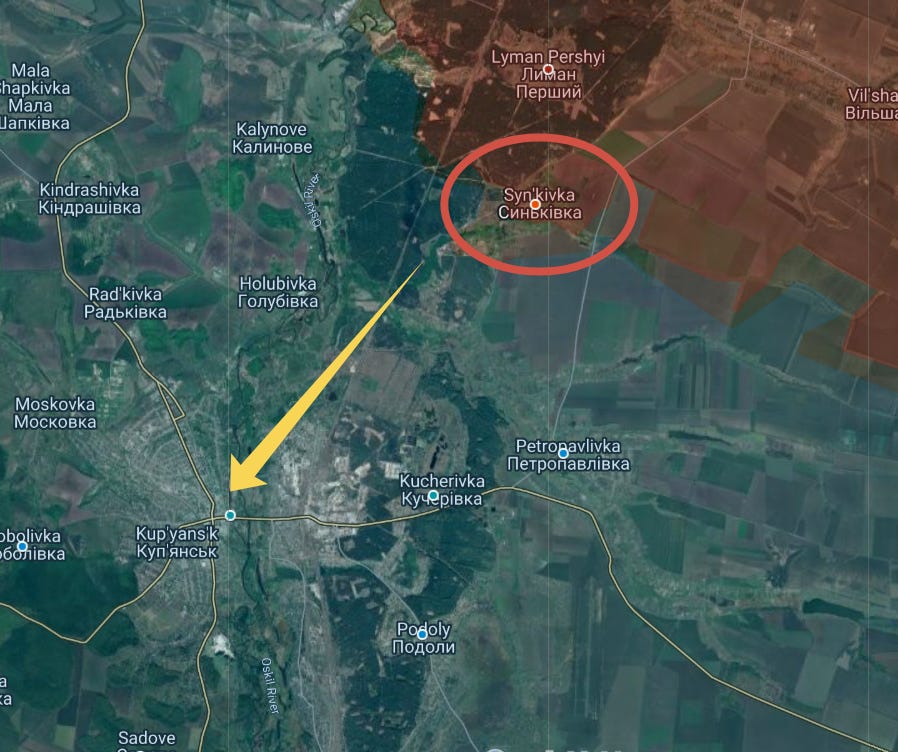
This is now confirmed, by the way; this town was prematurely declared ‘captured’ several times in the distant past, but this time we have the actual video of Russian troops planting a flag on the administration roof.
Then there were advances south of there, in Pischane. Followed by some gains in Chasov Yar, and the usual: in Toretsk, Pokrovsk direction, Selidove, etc. I don’t want to be premature, we still have to wait a little longer and see: but for now, it’s almost starting to feel like we’re at the moment where the water is seeping through the cracks in the wooden hull, signaling it could soon burst open, flooding the boat until it sinks.
Granted, the situation remains dangerous and tricky as Zelensky continues putting all his cards down on the Kursk direction, with rumors still going that a few remaining reserve brigades are being prepared for that final Zaporozhye gambit. Russia could still be caught with its pants down if the command staff is not fully vigilant at all times. But it does look like we’re getting closer and closer to the AFU’s breaking point. Granted—that could all change, there are still some emergency measures at Zelensky’s disposal, like mobilizing everyone from age 18 or even 16 and up; or, for all we know, Russian forces could still get exhausted from losses and grind to a halt—so don’t think it necessarily means the war is over. But things are definitely starting to break.
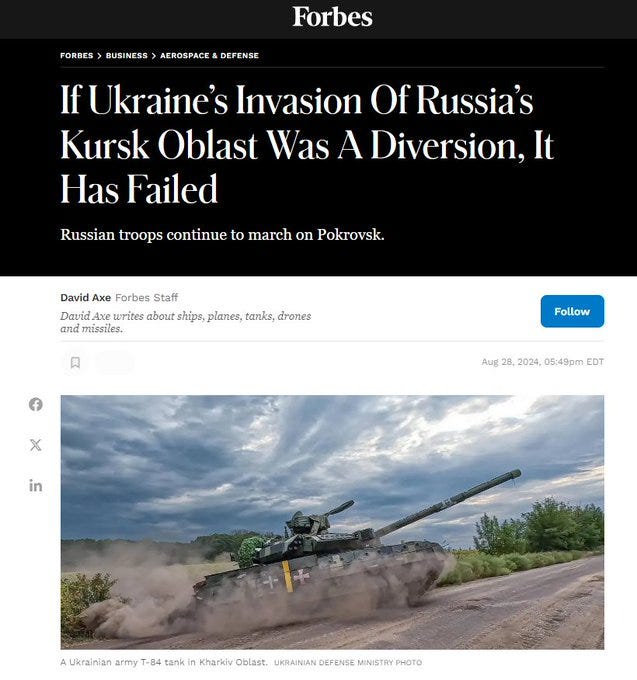
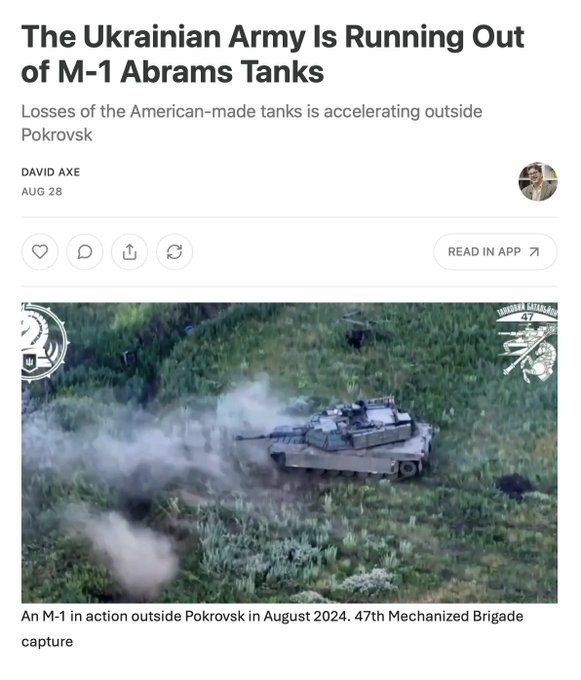
—
One respectable analysis of how Russia’s next advances will go in the Kurakhove direction:
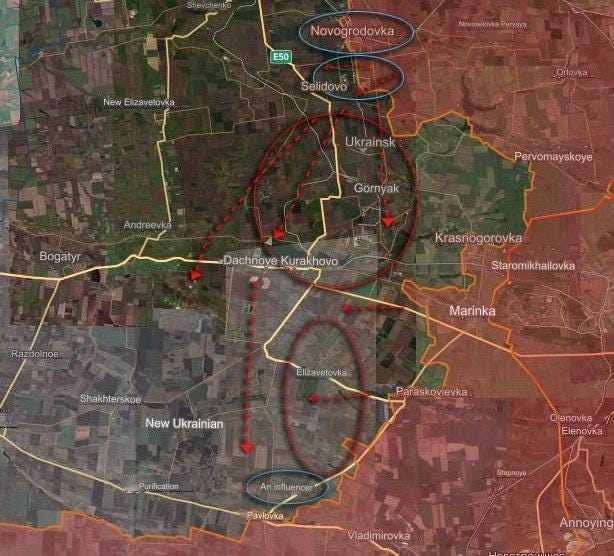
In the Pokrovsk direction, Selidovo is being stormed. However, the dynamics of events are very rapid (Novogrodovka was taken in 3 days), today Russian troops are already breaking through to the central areas of the city. Therefore, there is a possibility that the city will not hold out for long. Let’s simulate what might happen next.
If they take Selidovo, the Russians will probably begin the Kurakhovo operation. In fact, it is already partially advancing. Southeast of Mikhailovka (adjacent to Selidovo), enemy troops are advancing from captured Memrik to the outskirts of Ukrainsk and Galitsinovka. The Russians tried to enter the latter, but were repelled by the Defense Forces. Obviously, the assaults will continue, since the Russian Armed Forces intend to seize the heights in order to take fire control of the Karlovka-Kurakhovo road, along which the main supply of the Karlovka group goes.
After taking Selidovo and, accordingly, Mikhaylovka (it is almost entirely under Russian control), Russian forces will move to Ukrainsk . And after taking Ukrainsk and Galitsinovka, Ukrainian units in the area of the Karlovskoye Reservoir will have to retreat in order to avoid being encircled. Ukrainian troops will be forced to retreat behind the Kurakhovskoye Reservoir to the main nodal center here – Kurakhovo. And the enemy will occupy the northern shore of this reservoir.
At the same time, the second stage of the Russian offensive here will probably be the bypass of the Kurakhovo Reservoir. Thus, the Russian army will enter Kurakhovo from the west . The Ukrainian army does not expect such a maneuver now and, accordingly, did not build defensive structures (probably, only a hastily equipped defense will be built). Therefore, the Ukrainian Armed Forces will be forced to leave the city without serious fighting.
At the third stage, apparently, the Russian Armed Forces are planning the Ugledar operation. After the fall of Kurakhovo, the city will be in a semi-ring and in order not to end up in a cauldron, Ukrainian units there will probably be withdrawn.
In essence, this entire area is being turned into a big boiler:


Today’s videos:
Russian Pacific Fleet Marines demonstrate the new mobile warfare:
Combat work of assault units of the Pacific Fleet Marine Brigade of the Vostok force group Assault units of the Pacific Fleet Marine Corps unit of the Vostok group of forces successfully applied new tactics for capturing enemy strongholds using armored personnel carriers and mobile groups on motorcycles.
The assault armored group approaches the enemy positions on the armored personnel carrier at maximum speed, while continuously firing at the strong point from a 30-mm automatic cannon and a PKT machine gun. The task of the assault troops is to keep up with the armored vehicles. At the same time, mobile groups are deployed on motorcycles to the flanks of the strong point, which immediately, not allowing the enemy to raise their heads, enter the trenches and begin to advance towards each other, destroying the enemy’s manpower.
Now the assault units of the Pacific Fleet Marine Brigade from Kamchatka are pushing back the enemy in the area of the Vremyevsk salient. The settlements here have been turned by the Ukrainian Armed Forces into huge fortified areas, the approaches to them are flooded with enemy strongholds. In addition, most of the approaches are mined. According to the fighters, enemy drones are almost always in the sky, attacking at the slightest opportunity. But the Marines have learned to evade danger from the air, using the speed and maneuverability of motorized vehicles.
Successful assaults are preceded by serious preparation of each operation in the rear area. The latest successes in the South Donetsk direction of the special operation became possible, among other things, thanks to volunteers who signed contracts for military service with the Russian Ministry of Defense.
—
An Iskander struck an AFU complex in Krivoy Rog:
The characteristic profile can be seen in a freeze-frame:
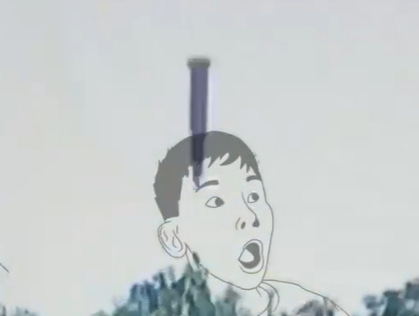
—
Kurganmashzavod has shipped its latest echelon of new BMP-3s and BMD-4Ms to the front:
—
Lastly, an update on the mysterious green UFO light being seen by AFU servicemen on the front—the same source from last time informs us it is a new Russian Zala laser targeting drone:
